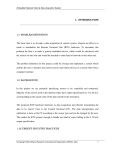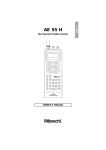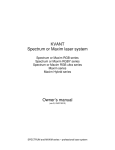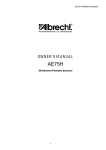Download Bai BA-220 Specifications
Transcript
INSTALLATION AND MAINTENANCE MANUAL FOR BA-220 DualBeam BARCODE READER revised 1/31/2009 Barcode Automation inc. Doing It Better - Because We Care. 800-528-9167 407-327-2177 FAX 407-327-6172 Post Office Box 195268 Winter Springs, FL 32719-5268 email [email protected] web page http://www.Barcode-Automation.com FOREWORD The purpose of this manual is to provide information on how to install, configure, operate, and maintain the Barcode Automation BA-220 DualBeam Barcode Reading and Access Control System. Barcode Automation Inc. has made every effort to insure that the information in this manual is both accurate and adequate. It is recommended, in the interest of safety and efficiency, that each section be read carefully before installing or servicing this system. This manual may not be copied or reproduced, in whole or in part, without the express written consent of Barcode Automation inc. Copyright 2009 Barcode Automation inc. All rights reserved January 2009 Copyright 1999-2009, Barcode Automation, inc. 2 INTRODUCTION This section contains information for proper installation, operation and maintenance of the Barcode Automation BA-220 DualBeam Barcode Reader. Each item in this section should be read completely before proceeding to other sections of this manual. If there are any questions contact Barcode Automation, inc at 1-800-528-9167 for assistance. FCC CLASS A STATEMENT This equipment generates, uses, and can radiate radio frequency energy and, if not installed and used in accordance with this manual, may cause interference to radio communications. A class A computing device, as defined in Part 15, Subpart J of the Federal Communications Commission rules is designed to provide reasonable protection against such interference when operated in a commercial environment. Operation of this equipment in a residence is likely to cause interference in which case the user, at his own expense, will be required to take whatever measures necessary to correct the interference. CDRH COMPLIANCE STATEMENT This laser barcode reading system complies with Standard 21CFR, Subchapter J, for Class II laser products as set forth by the Center for Devices and Radiological Health. Any alteration or adjustment for Class II laser products is not authorized, and will void certification of the system as a Class II laser product. Figure 1 on page 5 shows the type and location of warning labels affixed to the reader in compliance to the CDRH standard. SAFETY PRECAUTIONS This Barcode Reader incorporates features that provide for maximum safety. However, it must be recognized that any equipment employing electrical voltage and emitting direct or scattered radiation may cause serious damage and/or personal injury if improperly handled. The following are recommended safeguards that should be observed at all times. Copyright 1999-2009, Barcode Automation, inc. 3 WARNING Use of controls, adjustments or performance of procedures other than those specified herein may result in exposure to hazardous radiation or electrical voltages. OPTICAL SAFETY Never stare directly into laser beam. The laser diode is interlocked with the motor that turns the polygon mirror so that if the motor slows or stops for any reason the laser will be automatically turned off. ELECTRICAL SAFETY Disconnect the main power line before working on any electrical equipment. Always use insulated tools. Copyright 1999-2009, Barcode Automation, inc. 4 REQUIRED MAINTENANCE REQUIRED MAINTENANCE The BA-220 DualBeam laser window should be cleaned both inside and outside as needed with a BA-220 non-abrasive glasswindow cleaner. should be cleaned as needed with a nonThe laser abrasive glass cleaner. Optical components inside the reader should The internal reader optics should be cleaned at 6 month intervals with 100% denatured be inspected and cleaned at 6ormonth intervals. alcohol and soft material such as tissue soft toilet paper. DO These NOT USEinclude: OPTICAL CLEANING MATERIAL SOLD FOR CAMERA LENSES. The internal optic pieces to be cleaned are: • Window glass both inside and outside 1. Each of the 8 sides on the gold mirror wheel in the upper right corner of the reader should be cleaned using a wet (100% denatured alcohol) tissue followed by a dry tissue. This • 8 sided gold mirror wheel wheel is a metal part that is polished to a reflective surface, so use light pressure to (Polygon) prevent scratches. 2. Below the gold mirror wheel is a small silver mirror to clean. 3. Below the small silver mirror is a glass lens in a silver block to clean. • Small mirror below gold wheel (Polygon) • “Fisheye” lens in the silver block below the small mirror GND Tx Rx Optics should be cleaned with 100% denatured alcohol and soft material such as Kleenex® or cotton balls. DO NOT USE LENS CLEANING MATERIAL or OPTICAL WIPES. These will scratch the metal of the gold wheel and degrade reader performance. Cleaning is best accomplished by removing the decoder module from the reader as follows: 1. Remove wiring harnesses from decode module at J1, J5, and J13. 2. Remove 4 nuts securing the decode module to the main board and remove it from the reader. 3. Clean the inside window glass on the reader enclosure. 4. Clean all 8 mirror sides on the gold wheel (polygon). 5. Clean the small mirror directly below the gold wheel (polygon). 6. Clean the lens in the receiver block located below the small mirror. 7. Place decode module back in the reader enclosure. Reinstall the 4 nuts and tighten securely. 8. Reinstall the wire harnesses at J1, J5, and J13. Do not loosen or remove any hardware other than that specified in these directions. Any alteration to the laser alignment may result in poor reader performance. If you have a question contact BAI at 800-528-9167. Copyright 1999-2009, Barcode Automation, inc. 5 Warning Label Placement CAUTION LASER LIGHT WHEN OPEN DO NOT STARE INTO BEAM AVOID EXPOSURE LASER LIGHT IS EMITTED FROM THIS APERTURE CLASS II LASER PRODUCT THIS PRODUCT CONFORMS TO DHHS REGULATION 21 CFR SUBCHAPTER J. NOT USER SERVICEABLE CAUTION LASER LIGHT DO NOT STARE INTO BEAM 658nm LASER DIODE 1.0 MILLIWATT MAX. OUTPUT CLASS II LASER PRODUCT Copyright 1999-2009, Barcode Automation, inc. 6 Contents Foreword ............................................................................ 2 Introduction ......................................................................... 3 FCC Class A Statement ........................................................ 3 CDRH Compliance Statement............................................... 3 Safety Precautions............................................................... 3 Optical Safety ...................................................................... 4 Electrical Safety ................................................................... 4 Required Maintenance ......................................................... 5 Warning Label Placement..................................................... 6 General Specifications ......................................................... 8 Input Power ................................................................... 8 Environmental ................................................................ 8 Communications ............................................................ 8 Read Trigger.................................................................. 9 Optical........................................................................... 9 Scan Pattern ....................................................................... 9 Basic Installation and Setup Steps ........................................ 10 Determine where the Reader will be installed ................... 10 What Wiring do I need? .................................................. 13 Typical Installation Illustration ............................................... 16 Interface Connections for 115VAC unit .................................. 17 Interface Connections for 24VDC unit ................................... 18 Surge Module Installation Detail............................................ 19 Surge Module Replacement Instructions ............................... 20 Connecting to the BA-220 .................................................... 22 115VAC power input ....................................................... 22 24VDC power input ........................................................ 22 Input/output connections................................................. 23 Finishing the BA-220 Installation ........................................... 24 Mounting Angle.................................................................... 25 Powering up the BA-220 for the first time............................... 25 LED Indicators..................................................................... 26 Barcode label placement on vehicles .................................... 28 Copyright 1999-2009, Barcode Automation, inc. 7 General Specifications INPUT POWER For 115VAC input: Voltage 100 - 125VAC, 50 - 60 Hz Current draw typically 0.8 Amps@120VAC Power dissipation 40 Watts typical, 100 Watts maximum with heater on For 24VDC input: Voltage 22 - 30VDC Current draw 2.5 Amps Power dissipation 30 Watts typical, 60 Watts maximum with heater on CIRCUIT PROTECTION For 115VAC input: 2.5A 250V fuse located on mainboard For 24VDC unit: 3A resettable PTC located on mainboard ENVIRONMENTAL Operating Temperature –22°F to 130°F (-30°C to 55°C) Relative Humidity 10% to 100% non-condensing COMMUNICATIONS RS232 serial port configured for 8 data bits, no parity, 1 stop bit Baud rate selectable 1200, 2400, 4800, 9600, 19200, 38400 USB Port - requires driver installation on computer Wiegand 26 bit format Timing of Wiegand signal is adjustable Copyright 1999-2009, Barcode Automation, inc. 8 General Specifications READ TRIGGER Continuous Scan Loop Detector Input OPTICAL Reading area begins 24” from enclosure and extends out to 72” The laser lines are vertical with a fan shaped read area. 96 90 84 Read area chart in inches above pavement. 78 72 66 60 This assumes that 54 the center of the 48 BA-220 42 DualBeam 36 window is 54” 30 above the 24 pavement. A B C 18 12 6 6 12 18 24 30 36 42 48 54 60 66 72 78 84 90 96 Reading distance in inches from the body of the BA-220 DualBeam. Barcodes will be read in zones A, B, and C under normal conditions. Zone B coverage is guaranteed in all reasonable driving conditions. Copyright 1999-2009, Barcode Automation, inc. 9 Basic Installation and Setup steps 1. Determine where the Reader will be installed 2. Run wiring to the mounting point for power & communications 3. Pour concrete pad for post mount 4. Secure mounting post and BA-220 DualBeam to the pad 5. Connect power & communications to the reader 6. Place decals on vehicles (the same side the reader will be on) 7. Turn Power Switch On 8. You're up & running If the BA-220 DualBeam was not set up for your specific installation at the Factory you will have to configure the Reader after it is mounted in place. To do this refer to the Operation and Configuration Manual for details. Determine where the BA-220 DualBeam will be installed: 18’ to 25’ Approx 1 car length BA-220 DualBeam Overhead view of Installation As shown in this figure, the reader should be located at least one car length (plus a small gap) before the gate. It does not matter which side of the road it is mounted on, as long as the vehicle decals are on the same side. Always locate the reader and decals on the same side of the car. Copyright 1999-2009, Barcode Automation, inc. 10 Determine where the BA-220 DualBeam will be installed: In this side view, the important dimension is the height of the reader above the pavement. The general rule of thumb is for the bottom of the reader to be 40” above the pavement where the vehicle tires are located. Bottom of reader should be about 40” above the pavement BAI offers a standard mounting post that is 34” high. It is intended to be used on a 6” curb or concrete mounting pad for a total height of 40”. To fabricate a mounting post refer to the appendix for drawings. 6’ read distance BA-220 DualBeam The reader should be mounted close to the edge of the road or drive without being in danger of collision with a vehicle. It has a 6 foot reading distance which will extend out across the road or drive. Traffic should not pass by closer than 2 feet from the reader. Protective bollards or barriers around the BA-220 DualBeam is recommended. Copyright 1999-2009, Barcode Automation, inc. 11 Determine where the BA-220 DualBeam will be installed: Automatic Reader Lane 6’ read distance In some locations the vehicle drive is very wide, as shown in the illustration above. In these cases, we recommend painting lane lines or stripes to indicate where the vehicle must pass by in order to be read by the BA-220 DualBeam. Copyright 1999-2009, Barcode Automation, inc. 12 What Wiring do I need? For most applications, there are three basic ways to use the BA-220 DualBeam Reader. As a Stand Alone Access Control 115VAC or 24VDC Gate 2 wires for relay contacts ♦ ♦ ♦ ♦ BA-220 DualBeam reads the barcode and if Valid closes relay contacts to Open Gate Up to 100,000 different label numbers can be programmed Configure the BA-220 DualBeam with a Laptop Computer Change access control database with Laptop In this situation, the BA-220 DualBeam reader acts as the Access Control. Barcode decal numbers are programmed into the reader and set to grant or deny access based on the individual number. The reader can be programmed via a laptop computer or an optional modem tied into a phone line. When vehicles pass by the BA-220 DualBeam reads the barcode and checks to see if that number has access. If access is granted the Good Read relay contact closes to open the gate. If access is denied the gate does not open and an optional No Read relay contact will close that can be connected to an indicator or alarm to indicate that access is denied. Wiring Needed: • 2 conductor 18 AWG from reader to gate operator • 3 conductor for AC power connection (follow local electrical codes) • 2 conductor 18 AWG for 24VDC power connection Optional: Shielded 3 conductor 18 AWG for connecting RS232 serial port of reader to computer. Distance should not exceed 100 feet. Copyright 1999-2009, Barcode Automation, inc. 13 What Wiring do I need? Reader connected to Access Control Panel Access Control Panel 115VAC or 24VDC Gate 3 wires for Wiegand Signal ♦ ♦ ♦ ♦ ♦ BA-220 DualBeam reads barcode decal and sends number to Access Panel Panel determines if the decal number is Valid and controls gate Configure BA-220 DualBeam with a Laptop Computer Change access control database through the Access Control Panel Works with any Access Control Panel with 26 bit Wiegand Interface In this situation the BA-220 DualBeam is connected to an external Access Control panel by Wiegand communication. The barcode ID numbers are programmed into the Access Control panel and set up to have access granted or denied. When the vehicle pulls up to the BA-220 DualBeam it reads the decal and transmits the number to the Access Control panel, which checks the database for valid numbers. If access is granted, the panel opens the gate. Wiring Needed: • Shielded 3 conductor 18 AWG from reader to access control panel for Wiegand communication • 3 conductor for AC power connection (follow local electrical codes) • 2 conductor 18 AWG for 24VDC power connection Copyright 1999-2009, Barcode Automation, inc. 14 What Wiring do I need? Continued… Reader connected to Computer Security System Computer System 115VAC or 24VDC Gate 3 wires for RS232 Signal ♦ ♦ ♦ ♦ ♦ BA-220 DualBeam reads barcode decal and sends data to Computer System Computer System determines if the number is Valid Configure BA-220 DualBeam through the Computer System or Laptop Change access control database through the Computer System Works with any Computer System with RS232 or Wiegand Interface In this application the BA-220 DualBeam is connected to a Computer Security System through an RS232 serial port. Barcode decal ID numbers are programmed into the Computer Security system. When a vehicle pulls up to the BA-220 DualBeam reader, it reads the decal and transmits the number to the Security system. If valid, the Security system opens the gate. Power Input For 115VAC - Three wires (Ground, Neutral, Hot) Refer to local building code for requirements. For 24VDC - Two wires (Ground and +24VDC) Recommend 18 AWG Refer to local building code for requirements. Communications For RS232 interface - Three wires (Transmit, Receive, Ground) Minimum 3 conductor shielded cable 18 AWG For Wiegand interface - Three wires (Wiegand 0, Wiegand 1, Ground) Minimum 3 conductor shielded cable 18 AWG For Optional I/O Good Read relay - Two wires 18 AWG No Read relay - Two wires 18 AWG Loop Detect - Two wires 18 AWG Copyright 1999-2009, Barcode Automation, inc. 15 Typical Installation Illustration With a 34” mounting post, and a 6” curb, the BA-220 DualBeam (at 24” from the housing) can read barcode decals between 36” and 65” above the pavement . 24" 67" 34" 40" 35" 9" 6" Copyright 1999-2009, Barcode Automation, inc. 16 Connections for 115VAC unit Program Default Com Reset Serial Communication Connectors DB9F 1. Straight serial cable connection. 2. Null modem GND Tx Rx +12VDC LED (Yellow) +5VDC LED (Red) USB Connector (B) -12VDC LED (Green) Power Supply Heater and Fan Relays Power On Indicator (Orange) K1 - Loop Input K2 - Heater K3 - Good Read/ Open Gate K4 - No Read/Alarm Power Switch Lower left mounting screw Terminal Block Connections BA-SSM-115 Surge Module Ground Neutral Hot Green White Black Connect to AC power Green Green White Black +NO READ -NO READ +GOOD READ -GOOD READ +LOOP -LOOP +12VDC GROUND WIEGAND HOLD GROUND WIEGAND 1 WIEGAND 0 Copyright 1999-2009, Barcode Automation, inc. Isolated Wiegand Module Access Panel Yellow Gray Orange White Data 0 Blue Green Common Data 1 17 Connections for 24VDC unit Program Switch Default Com Switch Reset Switch Serial Communication Connectors DB9F 1. Straight serial cable connection. 2. Null modem serial connection. GND Tx Rx +12VDC LED (Yellow) +5VDC LED (Red) USB Connector (B) -12VDC LED (Green) Power Supply Heater and Fan Relays Power On Indicator (Orange) K1 - Loop Input K2 - Heater K3 - Good Read/ Open Gate K4 - No Read/Alarm Power Switch Power Connections GROUND NEUTRAL GROUND LINE +24VDC (HOT) Terminal Block Connections +NO READ -NO READ +GOOD READ -GOOD READ +LOOP -LOOP +12VDC GROUND WIEGAND HOLD GROUND WIEGAND 1 WIEGAND 0 Copyright 1999-2009, Barcode Automation, inc. Isolated Wiegand Module Access Panel Yellow Gray Orange White Data 0 Blue Green Common Data 1 18 Surge Module Installation Detail Connect to Computer Ground TX RX Green Gray Yellow Green Green Gray Yellow GND Tx Rx BA-SSM-RS232 Surge Module Lower left mounting screw Heater and Fan BA-220 Mainboard Lower left mounting screw Terminal Block Connections BA-SSM-115 Surge Module Ground Neutral Hot Green White Black Connect to AC power Green Green White Black +NO READ -NO READ +GOOD READ -GOOD READ +LOOP -LOOP +12VDC GROUND WIEGAND HOLD GROUND WIEGAND 1 WIEGAND 0 Copyright 1999-2009, Barcode Automation, inc. Isolated Wiegand Module Access Panel Yellow Gray Data 1 Orange White Data 0 Blue Green Common 19 Surge Module Replacement Instructions Surge Protection modules from BAI are sacrificial - if a powerful surge occurs they will open to protect the reader electronics. Surge modules cannot be repaired, they can only be replaced. Important Safety Note: Turn reader power off before installing surge modules. 115VAC input readers must be turned off at the breaker panel. 115VAC Surge module BA-SSM-115 (Black Case) 1. Turn reader power switch off. (for Safety, 115VAC input readers must be turned off at the breaker panel) 2. Disconnect old surge module and retain for warranty validation. 3. One side of module has three wires 6” long. This must be wired to the AC line from the circuit breaker with Black to HOT, White to NEUTRAL, Green to GROUND. 4. Other side of module has four wires 4” long. These wires go to the mainboard terminal block. The Green wire with the ring lug goes to the lower left mounting screw for the mainboard. The Black wire goes to HOT, White to NEUTRAL, Green to GROUND at TB1. 5. Once wiring is complete turn power on at breaker and then turn reader power switch ON. Isolated Wiegand module BA-Isolated Wiegand (Green Case) 1. Turn reader power switch off. 2. Disconnect old module and retain for warranty validation. 3. One side of module has three wires 6” long. This must be wired to the Wiegand communication line from the access panel or telephone entry system with White to WIEGAND 0, Gray to WIEGAND 1 and Green to GROUND (Common). 4. Other side of module has three wires 4” long. These wires go to the mainboard terminal block. The Orange wire goes to WIEGAND 1, Blue to WIEGAND 0 and Yellow to +12VDC at TB18. 5. Once wiring is complete turn reader power switch ON. Copyright 1999-2009, Barcode Automation, inc. 20 Surge Module Replacement Instructions Important Safety Note: Turn reader power off before installing surge modules. RS232 surge modules are optional accessories and must be ordered separately. They should be used only for RS232 communications that are wired permanently from the reader to a computer interface. The Surge module is not necessary when temporarily connecting a laptop for diagnostics. RS232 Surge module BA-SSM-RS232 (Blue Case) 1. Turn reader power switch off. 2. Disconnect old surge module and retain for warranty validation. 3. One side of module has three wires 6” long. This must be wired to the RS232 communication line from the computer system with Yellow to RX, Gray to TX and Green to GROUND. 4. Other side of module has four wires 4” long. These wires go to the decoder terminal block. The Green wire with the ring lug goes to the lower left standoff for the decoder. The Yellow wire goes to RX, Gray to TX and Green to GROUND at J12 on the decoder board. 5. Once wiring is complete turn reader power switch ON. Copyright 1999-2009, Barcode Automation, inc. 21 Connecting to the BA-220 DualBeam 115VAC power input The power input terminal block for 115VAC input from the surge suppressor is marked: GROUND NEUTRAL LINE (HOT) Connect each wire to the proper input on the terminal block. 24VDC power input The power input terminal block for 24VDC input is marked for the Ground and +24VDC leads. The top connection is not used. Note: The 24VDC input must supply 2.5 Amps minimum to the Reader for it to operate correctly. GROUND +24VDC Connect each wire to the proper input on the terminal block. Copyright 1999-2009, Barcode Automation, inc. 22 Connecting to the BA-220 DualBeam Input/Output connections The No Read and Good Read output terminals connect through optional relays. The + Loop and - Loop connections are for an optional input from a loop detector or other dry contact device. The +12VDC terminal is an output and provides power to run accessories such as an external modem. It should not be used for devices that need more than 500mA of current. The Ground terminals (both of them) connect to the BA-220 DualBeam electronic circuit ground. The Wiegand Hold terminal is not implemented and should not be connected. Wiegand 1 and Wiegand 0 are the Wiegand communication terminals. The Wiegand Isolator (Green case) module should be connected here. +NO READ -NO READ +GOOD READ -GOOD READ +LOOP -LOOP +12VDC GROUND WIEGAND HOLD GROUND WIEGAND 1 WIEGAND 0 Copyright 1999-2009, Barcode Automation, inc. 23 Finishing the BA-220 DualBeam Installation After the Reader is mounted and the wiring is connected, all of the openings in the bottom of the enclosure must be sealed off. Use silicone, RTV, or other sealant to close off the opening in the bottom so it is watertight. If there is condensation on the laser optics, the Reader may not read barcodes well or at all. To prevent moisture from entering the enclosure, seal off the opening as described above. Then, open the plastic bag containing the desiccant pouch and remove it. Place the brown pouch and the humidity indicator card flat on the bottom of the unit before closing the door and tightening the latches. The desiccant will absorb moisture from the air in the Reader for a long time before becoming saturated. Note: Put the desiccant in the reader AFTER the installation is complete and you are ready to close up the box. Each time you open the Reader for service immediately check the humidity indicator card. If the humidity card circles are all pink, change out the desiccant pouch and replace it with a fresh one. BE SURE TO CHECK THE HUMIDITY CARD FIRST WHEN OPENING THE READER. After the door is opened, the card will react to humidity in the outside air and usually turn pink to show how humid the outside air is. As long as the card is not all pink when you first open the door there is no need to change the desiccant bag. HUMIDITY INDICATOR If all 3 blue circles are pink when Reader is first opened the desiccant should be changed. Copyright 1999-2009, Barcode Automation, inc. 24 Mounting Angle Curb BA-220 The BA-220 DualBeam should be aimed straight across the road as shown. Car Window Powering Up the BA-220 DualBeam When testing the BA-220 DualBeam you should have a laptop computer on hand that can communicate with the reader. The reason for this is to take advantage of the diagnostics and test programs that are built in to the unit. For more information on how to communicate with the reader refer to the Operation and Configuration Manual. When the BA-220 DualBeam is powered on: • The Main Power indicator should light up • The +12VDC LED (yellow), +5VDC LED (red) and –12VDC LED (green) should light up on the mainboard (See pages 16 - 17) • The fan should begin spinning • The gold mirror wheel (also known as the polygon) will spin Approximately 15 - 30 seconds after the main switch is turned on: • The laser should turn on • The yellow LED on the decoder (Lsr Act) will turn on • The yellow indicator light on the outside of the box will turn on The BA-220 DualBeam is now ready to read barcodes. Copyright 1999-2009, Barcode Automation, inc. 25 LED Indicators Look on the left hand edge of the decoder circuit board (the one that has the gold wheel spinning). There are LED indicators for several functions located in a column. From top to bottom they are: Gd Read (Green) - will light for approx 1 second when a decal is read Lsr Act (Yellow) - should be on when the laser is on Rst Act (Green) - will light when the unit is being reset Data0 Act (Red) Data1 Act (Red) These LED’s indicate when the Wiegand communication lines (data 0 and data 1) are active. When the BA-220 DualBeam is not transmitting, the LED’s should be off. If one or both of the LED’s are on constantly the data line is connected to ground. Remove the wires connected to Wiegand 1 and Wiegand 0 and see if the LED’s go off. If they do, the wiring may be at fault. Trace the communication wiring and be sure it is connected properly to the access control equipment. Loop In (Yellow) - will light when the loop input is active DigLo (Yellow) - will light when data is flowing from receiver board DigHi (Yellow) - will light when data is flowing from receiver board Diag (Green) - will light when decoder is in programming mode Heat (Red) - will light when heater is turned on Sync (Green) - will light when gold wheel is spinning Reading a test barcode: Refer to page 28 for how the barcode must be held for the BA-220 DualBeam to read it. Then, pass the barcode through the laser line. The green indicator on the outside of the box should light up for approximately 1 second to show that the barcode was read. Also, Gd Read (green) on the left edge of the decoder circuit board should also light up for 1 second. Copyright 1999-2009, Barcode Automation, inc. 26 LED Indicators Continued… Important: The BA-220 DualBeam will not read the exact same barcode number until at least 1 second has passed since the first time it was read. Remember to wait 1 second between reads before trying to scan the same barcode. If you try to read it again sooner, the BA-220 DualBeam will ignore it. If a different barcode number is read, you will see the green indicator light. The only time you need to wait 1 second between reads is if you have only 1 barcode number to test with. As you pass the barcode through the laser line watch the two red LED’s (Data0 Act and Data1 Act) that show the status of the Wiegand data lines. When the barcode is read, both should “flash” or “flicker” red very quickly. These “flashes” indicate that the BA-220 DualBeam has sent out the Wiegand communication pulses for the barcode. Note: These “flashes” are very fast - to be certain to see them look directly at the indicators and shade them from the Sun if necessary. At this point the BA-220 DualBeam is ready for operation. Copyright 1999-2009, Barcode Automation, inc. 27 Barcode Label Placement on Vehicles YES 12345 12345 NO 1. Always place the decals on the same side of the vehicle that the reader is on. 2. Apply to the outside of the window glass. Decals will not read reliably through the glass. 3. Orient decal with the stripes running horizontal. (as shown). 4. The bottom of the decal should be at least 36 inches above the ground. 5. The top of the decal should be no more than 65 inches above the ground. 6. Always prepare the window before applying the decal by scrubbing with SoftScrub or other mild abrasive cleaner. Do not use glass cleaners that contain silicone. Copyright 1999-2009, Barcode Automation, inc. 28







































